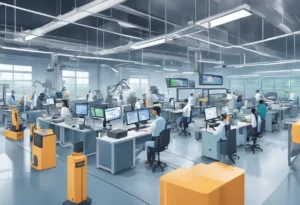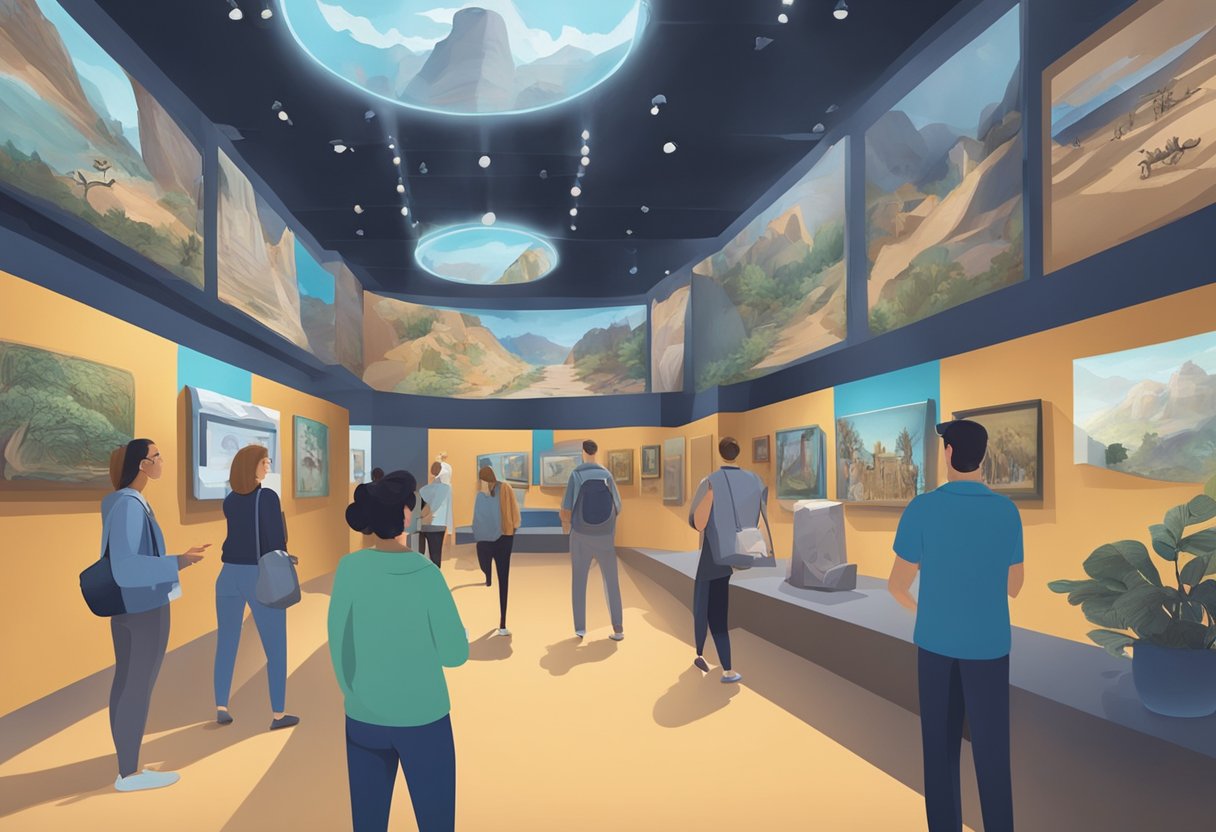Augmented Reality (AR) is a technology that has been around for several decades and has evolved significantly over time. It is a technology that enables users to interact with digital objects and information in the real world. AR has become increasingly popular in recent years, with various industries adopting it for different purposes.
The history of augmented reality dates back to the 1950s when Morton Heilig, a cinematographer, developed the Sensorama, which provided the viewer with visuals, sounds, vibration, and smell. It was the first attempt at adding data to an experience, although it wasn’t computer-controlled. The concept of AR was later introduced in a novel by Frank L Baum in 1901, where a set of electronic glasses mapped data onto people; it was called a “character marker.”
AR technology was invented in 1968, with Ivan Sutherland’s development of the first head-mounted display system. However, the term ‘augmented reality’ wasn’t coined until 1990 by Boeing researcher Tim Caudell. Since then, the technology has come a long way, with a growing list of use cases for AR. In this article, we will explore the foundations of augmented reality, technological advancements, AR in various industries, user interface and interaction, and the future of augmented reality.
Key Takeaways
- Augmented reality technology has been around for several decades and has evolved significantly over time.
- The history of augmented reality dates back to the 1950s when Morton Heilig developed the Sensorama.
- AR technology was invented in 1968, and the term ‘augmented reality’ was coined in 1990 by Boeing researcher Tim Caudell.
Foundations of Augmented Reality

Early Concepts and Definitions
Augmented reality (AR) is a technology that enhances the real world by adding computer-generated information, such as sounds, images, and text. The concept of AR dates back to the early 1900s, when Frank L. Baum wrote about electronic glasses that could map data onto people in his novel. However, the term “augmented reality” was not coined until 1990 by Boeing researcher Tim Caudell.
Pioneers in AR Development
One of the pioneers in AR development is Ivan Sutherland, who invented the first head-mounted display system in 1968. The system, called the Sword of Damocles, used a computer-generated display to overlay graphics onto the real world. Another pioneer in AR development is Louis Rosenberg, who developed the concept of virtual fixtures in the early 1990s.
When was augmented reality invented
Augmented reality technology was invented in 1968, with Ivan Sutherland’s development of the first head-mounted display system. However, the term “augmented reality” wasn’t coined until 1990 by Boeing researcher Tim Caudell.
History of Augmented Reality Timeline
AR has come a long way since its inception. By the end of the 1990s, AR was used for field navigation by NASA. Today, AR is used in a growing list of use cases, including gaming, education, and healthcare.
History of AR Technology
AR technology has evolved significantly over the years. Early AR systems were based on analogue technologies, while modern AR systems are based on electronic and digital technologies. AR is now being used in a wide range of applications, including entertainment, education, and healthcare.
What was Augmented Reality First Used For
The first AR application was developed in 1968 by Ivan Sutherland, who created a head-mounted display system that overlaid computer-generated graphics onto the real world. The system was used to create virtual objects that could be manipulated in real time.
Who Invented Augmented Reality
Augmented reality was invented by Ivan Sutherland in 1968, when he developed the first head-mounted display system. However, the term “augmented reality” was not coined until 1990 by Boeing researcher Tim Caudell.
AR Technological Advancements

Head-Mounted Displays
Head-mounted displays (HMDs) are a significant technological advancement in the field of augmented reality. They are wearable devices that allow users to experience AR in a hands-free manner. The first HMD was invented by Ivan Sutherland in 1968, which was known as “The Sword of Damocles.” Since then, HMDs have evolved significantly, and today we have AR glasses like Google Glass, Microsoft HoloLens, and Magic Leap.
AR glasses have embedded hardware components like sensors, cameras, and processors that enable them to track the user’s movements and provide a seamless AR experience. The glasses display digital information in the user’s field of view, making it appear as if the digital objects are part of the real world.
AR Software and Applications
AR software and applications are essential components of augmented reality technology. AR software is responsible for processing data from the sensors and cameras and creating a digital overlay on the real world. AR applications are the end-user products that utilize AR technology to provide various services, such as gaming, education, and marketing.
AR software and applications have come a long way since the invention of the first HMD. Today, we have sophisticated AR software like Vuforia, ARKit, and ARCore, which enable developers to create high-quality AR applications. AR applications like Pokemon Go, IKEA Place, and Snapchat filters have become immensely popular among users.
Mobile Augmented Reality
Mobile devices like smartphones and tablets have played a crucial role in the widespread adoption of augmented reality technology. Mobile devices have become more powerful over the years, with faster processors and better cameras, making them ideal for AR applications.
Mobile AR applications use the device’s camera to capture the real world and overlay digital information on it. Users can interact with the digital objects using touch gestures and other input methods. Mobile AR applications are available on app stores like Google Play and the App Store, making them easily accessible to users.
Mobile AR has become an essential technology in various industries, such as education, healthcare, and entertainment. It has enabled developers to create immersive experiences for users, making learning and entertainment more engaging and interactive.
AR in Various Industries

Augmented Reality has found its way into various industries, including gaming and entertainment, education and training, and commerce and advertising.
Gaming and Entertainment
AR technology has revolutionized the gaming and entertainment industry. With AR games, players can interact with the game world in a more immersive way. Pokemon Go, the popular AR game, allows players to catch Pokemon in the real world. Similarly, the AR game Ingress allows players to capture virtual territories in the real world. AR technology has also been used in the entertainment industry to create immersive experiences. For example, the AR app Marta allows users to explore a virtual art gallery.
Education and Training
AR technology has been used in education and training to create immersive and interactive learning experiences. NASA has used AR technology to create virtual simulations of space missions to train astronauts. AR technology has also been used in classrooms to create interactive learning experiences. For example, the AR app Elements 4D allows students to explore chemical elements in a more interactive way.
Commerce and Advertising
AR technology has been used in commerce and advertising to create more engaging and interactive experiences for customers. IKEA has used AR technology to create an AR app that allows customers to visualize how furniture would look in their homes before making a purchase. E-commerce companies have also used AR technology to create virtual try-on experiences for customers. For example, the AR app Sephora Virtual Artist allows customers to try on makeup virtually before making a purchase.
AR technology has come a long way since its invention in 1968. It has found its way into various industries and has been used to create more engaging and interactive experiences for users.
AR User Interface and Interaction

Input Devices and Sensors
The success of augmented reality technology is heavily dependent on the user interface and interaction design. The input devices and sensors used in AR systems must be intuitive and easy to use, allowing users to interact with virtual objects seamlessly.
AR systems use a variety of input devices and sensors to track user movement and capture real-world data. These include accelerometers, gyroscopes, compasses, GPS, and RFID. AR systems may use visual markers, like QR codes, to track user movements and position virtual objects in the real world.
Speech recognition and eye tracking are also important input methods in AR systems. Speech recognition allows users to control virtual objects using voice commands, while eye tracking enables users to interact with virtual objects using eye movements.
User Experience and Accessibility
AR systems must be designed with user experience and accessibility in mind. The user interface and interaction design should be intuitive and easy to use, allowing users to interact with virtual objects seamlessly.
AR systems should also be accessible to users with disabilities. For example, AR systems could use haptic feedback to provide tactile feedback to users with visual impairments. AR systems could use speech recognition and voice feedback to provide audio cues to users with hearing impairments.
The success of augmented reality technology is heavily dependent on the user interface and interaction design. AR systems must use intuitive input devices and sensors, and be designed with user experience and accessibility in mind.
The Future of Augmented Reality
As technology advances, the future of augmented reality (AR) is looking bright. AR is expected to become a mainstream technology that will transform the way people interact with the world around them.
One of the most exciting developments in AR is the emergence of mixed reality (MR). MR is a combination of virtual and augmented reality that allows users to interact with virtual objects in the real world. This technology has the potential to revolutionize industries such as gaming, education, and healthcare.
Wearable technology, such as smart glasses, will also play a significant role in the future of AR. Smart glasses like the HoloLens 2 offer a hands-free AR experience, allowing users to interact with virtual objects while still being able to see the real world. This technology has the potential to transform the way people work, especially in industries such as manufacturing and logistics.
Extended reality (XR) is another area that is expected to grow in the future. XR is a term used to describe the combination of AR, VR, and MR. This technology has the potential to create fully immersive experiences that blur the line between the real and virtual worlds.
The future of augmented reality looks bright. As technology advances, we can expect to see more innovative AR applications that will transform the way we interact with the world around us.
Frequently Asked Questions
What are the origins of augmented reality technology?
The origins of augmented reality technology can be traced back to the 1960s when the first head-mounted display system was developed by Ivan Sutherland. However, the term “augmented reality” was not coined until 1990 by Boeing researcher Thomas Caudell.
How have augmented reality applications developed over time?
Augmented reality applications have rapidly developed over the past few decades. Initially, they were primarily used for military purposes, but now they have expanded to various industries such as healthcare, education, entertainment, and retail.
Which industries have been most transformed by augmented reality?
The industries that have been most transformed by augmented reality are retail, entertainment, and healthcare. Augmented reality has revolutionized the way retailers promote their products, how consumers shop, and how healthcare professionals diagnose and treat patients.
What are some significant milestones in the evolution of augmented reality?
There have been several significant milestones in the evolution of augmented reality. In the 1990s, the first commercial AR system was developed by KARMA (Knowledge-based Augmented Reality for Maintenance Assistance). In 2008, the first AR mobile application was released for the iPhone. In 2016, Pokemon Go became a worldwide phenomenon and brought augmented reality to the mainstream.
Who are the key figures in the development of augmented reality?
The key figures in the development of augmented reality are Ivan Sutherland, Thomas Caudell, Steve Mann, and Louis Rosenberg. Sutherland developed the first head-mounted display system, Caudell coined the term “augmented reality,” Mann invented wearable computing, and Rosenberg developed the augmented reality tool “Virtual Fixtures.”
How do augmented reality systems function technically?
Augmented reality systems use a combination of technologies such as cameras, sensors, and displays to overlay digital information on the real world. The cameras and sensors capture the real-world environment, and the computer processes the data and overlays digital information on top of it. The digital information is then displayed to the user through a display device such as a smartphone or a head-mounted display.




